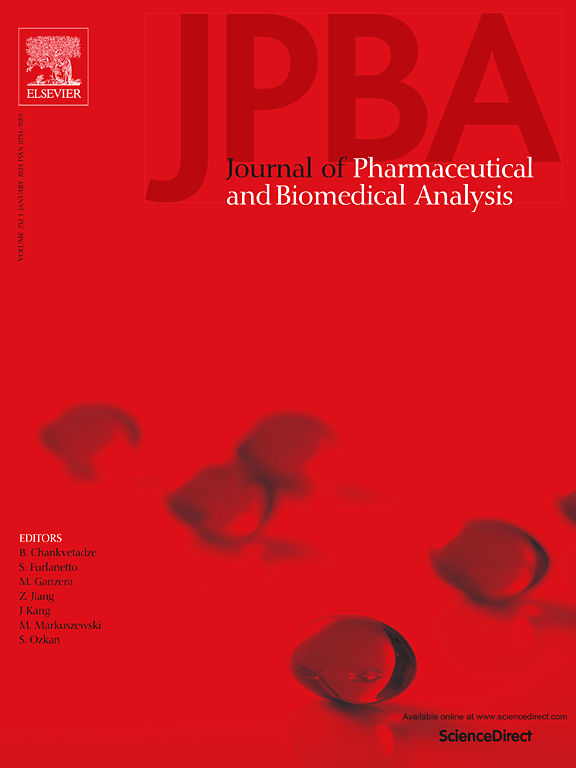Targeted LC-MS/MS method of oxylipin profiling reveals differentially expressed serum metabolites in type 2 diabetes mice with panaxynol
IF 3.1
3区 医学
Q2 CHEMISTRY, ANALYTICAL
Journal of pharmaceutical and biomedical analysis
Pub Date : 2024-10-22
DOI:10.1016/j.jpba.2024.116540
引用次数: 0
Abstract
Panaxynol is a bioactive polyacetylene in food plants; however, its specific benefits in diabetes and metabolic disorders remain unclear. Previous studies have mainly focused on biochemical indicators and clinical evaluations. Limited research has systematically elucidated the beneficial effects of panaxynol from the oxylipins perspective. In this study, we employed an oxylipin analysis platform we previously established using high-performance liquid chromatography-tandem mass spectrometry (HPLC-MS/MS) based on the multiple reaction monitoring (MRM) method for the profiling of oxylipins. After a 7-week administration of panaxynol to db/db mice, significant alterations in serum oxylipins and potential benefits to hyperglycemia, insulin resistance, and hepatic steatosis were observed. Our analysis also revealed correlations among epoxygenase products derived from arachidonic acid (AA), linoleic acid (LA), and α-linolenic acid (ALA) via cytochrome P450 (CYP) pathways. Furthermore, six potential oxylipins were identified, as offering insights into the mechanisms by which panaxynol may modulate diabetes. These results provide the first in vivo evidence of the impact of panaxynol on oxylipin metabolism and lay the foundation for developing panaxynol as a nutraceutical for diabetes management.
靶向 LC-MS/MS 氧脂素谱分析方法揭示了服用三七酚的 2 型糖尿病小鼠血清代谢物的表达差异。
板蓝根酚是食用植物中一种具有生物活性的聚乙炔,但它对糖尿病和代谢紊乱的具体益处仍不清楚。以往的研究主要集中在生化指标和临床评估方面。从氧磷脂角度系统阐明三七酚有益作用的研究有限。在本研究中,我们采用了之前建立的基于多反应监测(MRM)方法的高效液相色谱-串联质谱(HPLC-MS/MS)氧化脂素分析平台来分析氧化脂素。在对 db/db 小鼠进行为期 7 周的给药后,我们观察到血清中的氧化脂素发生了显著变化,并可能对高血糖、胰岛素抵抗和肝脏脂肪变性产生益处。我们的分析还揭示了花生四烯酸(AA)、亚油酸(LA)和α-亚麻酸(ALA)通过细胞色素 P450(CYP)途径产生的环氧化酶产物之间的相关性。此外,还发现了六种潜在的氧脂素,为了解三七酚调节糖尿病的机制提供了线索。这些结果首次在体内证明了三七酚对氧脂代谢的影响,并为将三七酚开发成糖尿病管理的营养保健品奠定了基础。
本文章由计算机程序翻译,如有差异,请以英文原文为准。
求助全文
约1分钟内获得全文
求助全文
来源期刊
CiteScore
6.70
自引率
5.90%
发文量
588
审稿时长
37 days
期刊介绍:
This journal is an international medium directed towards the needs of academic, clinical, government and industrial analysis by publishing original research reports and critical reviews on pharmaceutical and biomedical analysis. It covers the interdisciplinary aspects of analysis in the pharmaceutical, biomedical and clinical sciences, including developments in analytical methodology, instrumentation, computation and interpretation. Submissions on novel applications focusing on drug purity and stability studies, pharmacokinetics, therapeutic monitoring, metabolic profiling; drug-related aspects of analytical biochemistry and forensic toxicology; quality assurance in the pharmaceutical industry are also welcome.
Studies from areas of well established and poorly selective methods, such as UV-VIS spectrophotometry (including derivative and multi-wavelength measurements), basic electroanalytical (potentiometric, polarographic and voltammetric) methods, fluorimetry, flow-injection analysis, etc. are accepted for publication in exceptional cases only, if a unique and substantial advantage over presently known systems is demonstrated. The same applies to the assay of simple drug formulations by any kind of methods and the determination of drugs in biological samples based merely on spiked samples. Drug purity/stability studies should contain information on the structure elucidation of the impurities/degradants.

 求助内容:
求助内容: 应助结果提醒方式:
应助结果提醒方式:


